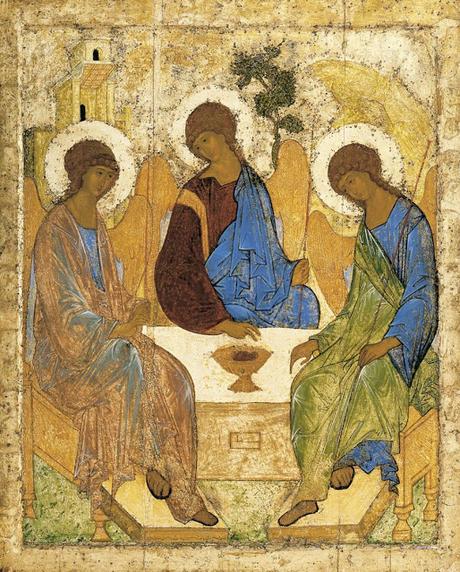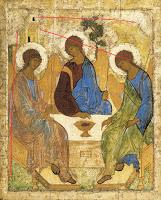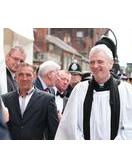John 16:12-15

If you visit the Tretyakov Gallery and go downstairs to the icon section, you will discover this icon.
It is Rublev’s icon of the Trinity and is one of the great gifts that Russian spirituality has given to the Christian world.It depicts an Old Testament event. Abraham, the great ancestor of the Jewish people, has settled by the oak of Mamre (Genesis 18:1-15). You can see the tree here in the center of the image. Three travellers are walking through the desert. Abraham, as was customary at the time, invites them to stop and rest, and provides them with food. So here you have Abraham’s house and the desert, and the three visitors, seated around a meal of lamb. Those who have investigated the original can make out the image of a lamb in the cup. After they have eaten, the guests tell Abraham that even though Sarah his wife is over 90, she will have the son that God promised them. And Abraham realises that he has entertained not just three travellers, but the Lord God himself. The passage says, ‘The Lord said ..’ And so - because we cannot depict God himself - the figures are shown as angels representing God, with wings.
But, and this is why it is helpful for us, 4000 years later, after the death and resurrection of Jesus, the early Christians, as they reflected on this story - came to understand that the three angels visiting Abraham represented the three persons of the Trinity: the Father, Son and Holy Spirit
There were many early icons that depict this scene. They usually show Abraham and Sarah, a full meal on the table, and servants and cattle.
But Rublev takes the traditional earlier image and simplifies it. That is one of the things that I find helpful in early Russian icons. They are simple. They focus on the essential. So out go the servants, out go Abraham and Sara, out go all the stuff on the table and what we are left with are the three angelic figures seated around a table with a single cup, and behind them a house, the tree and the desert.
And if we want to begin to understand the Trinity, then this is without doubt one of the most inspired places to start.
The three figures have the same face, are the same age, have the same funny hairstyle and they are seated on the same level. They have existed from before the beginning of time. They have always been. There has never been a time when they were not. And there is an equality about them. They all wear the blue of divinity and hold the sceptre of authority. They are each God, but together they are one: they are God.
But they are also represented as three different persons.
The angel on the left, wearing gold, represents the Father. The angel in the middle, wearing red and a priest’s scarf, represents the Son, Jesus Christ. The angel on the right, wearing green, represents the Holy Spirit, the giver of life.
Behind the Father is a house. Jesus speaks of the Father’s house. Behind the Son is a tree. We think of the tree of the cross, on which Jesus died so that we can be forgiven and have access to God. And we think of the tree of life. And behind the Spirit is the desert, the rock, the wilderness. That is the place where many people have met God: Moses, the people of Israel, David, Elijah. Even Jesus himself is led by the Spirit into the wilderness. So often people begin to really meet with God when we find ourselves in the literal or metaphorical wilderness.
But the important thing about the Trinity is that it is not a mathematical problem to be solved with Venn diagrams, or shamrocks, or ice/water/steam illustrations. It is about a relationship which is to be delighted in.
We look at the relationship, the movement, between the three persons.
The Son and the Spirit both incline their head to the Father. The Father is the one by whom they define themselves by. The Son is the beloved eternal child of the Father. The Spirit comes directly from the heart of the Father. And the Father blesses the cup, or blesses the Son and looks at the Spirit. And the Son blesses the cup (representing the sacrifice of Jesus) or blesses the Spirit, and looks at the Father. And the Spirit blesses the cup or the one standing in front of this icon - you or me - and looks at the cup.
So there is a circular movement of the heads that bow and a circular movements of the hands that bless; a movement of submission to the Father, and a movement of blessing from the Father.
The Trinity is not a problem to be solved. The Trinity is a relationship to be lived.
The Father loves the Son and delights in him. And the Son loves the Father and delights in him. The Father has given the Son all things. ‘All that the Father has is mine’ says Jesus in our reading today. And just as the Son loves the Father and seeks his glory, so the Spirit loves the Son and seeks his glory. ‘He will glorify me’, says Jesus. So the Spirit seeks the Son’s glory who seeks the Father’s glory. And in John 16 we are told how the Spirit will bring glory to the Son. He will take the things of Jesus (his love and his power and his truth and his glory) and stamp them to us. He will speak to us the words of Jesus: ‘he will not speak on his own, but will speak whatever he hears’. And he will make known to us the truth - which is Jesus. It is not that he will give us new additional teachings. The words in the text really mean that he will re-speak, re-declare the things that Jesus has already spoken to his apostles. In other words, he will apply those teachings to our hearts in the new and different circumstances that we find ourselves. Jesus has given us the template for life. It is the Spirit who will help us apply that template to the situation that we find ourselves in. And the Spirit will re-declare to us what will happen: that there will be suffering but also glory; that God’s kingdom will come; that there will be justice and evil will be defeated; that death does not have the final word; that Jesus will return and we will see him and be with him.
This is why the Trinity is not theoretical, but very personal.
The Holy Spirit invites us to join in this movement of blessing and submission. We are invited to stand in front of this icon. We are invited to join in this communion of Spirit, Son and Father. And as, by the invitation of the Holy Spirit, working in our hearts, and bringing to us the words of Jesus, the invitation of Jesus, we come close to receive the cup, so we come to Jesus himself. And as we come to Jesus, the Son, led by the Spirit, we discover that we are beside the Father.
So because of Jesus, and with Jesus, and because the Spirit has drawn us to Jesus, we can pray ‘Our Father in heaven’. Because of Jesus, you can approach Father God Because of Jesus, you can know the love of the Father, and you will begin to love the Father
There are many things here that I haven’t time to speak about, but I’d like to draw our attention to two things.
The first is that the shape of the Father and Spirit make a chalice.
And the second is something that I have only just seen, but could probably be the most important thing about this icon. If you look at it, where are your eyes drawn? To the cup, because it is central? To the feet and to the place in front of the icon where you or I are invited to stand, because that is where the so-called reverse perspective draws us?
But in fact, I think that the focus is, in fact, on the house in the top left.
 The rock and the tree incline towards the house. The line that you draw from the head of the Spirit and the Son directs us to the house And the line going up the back of the Father leads to the house
The rock and the tree incline towards the house. The line that you draw from the head of the Spirit and the Son directs us to the house And the line going up the back of the Father leads to the house It is the house of the Father. It is the house with the open window, from which the Father looks to see us coming. It is the house with the open door, from which the Father runs to greet the person who takes but the first step towards him.
And it is the house of the Father, Son and Holy Spirit, which is our eternal home.

